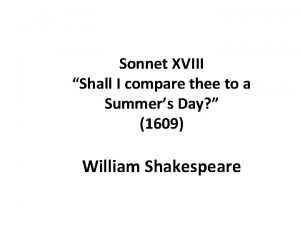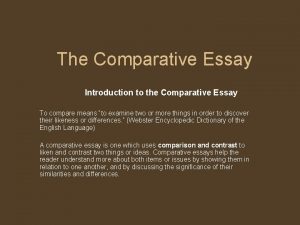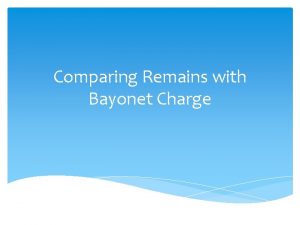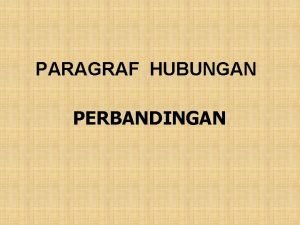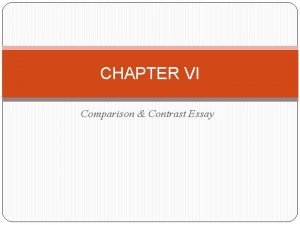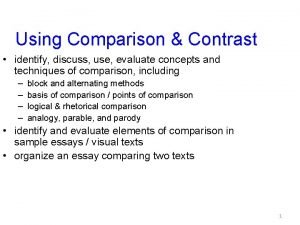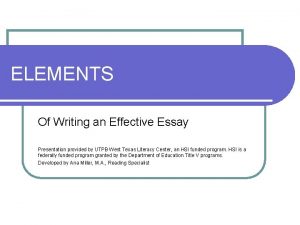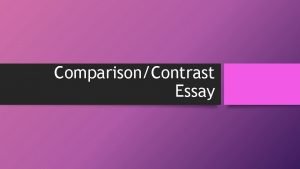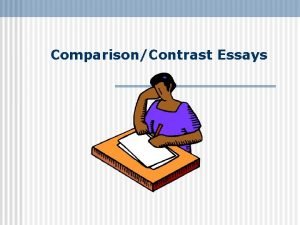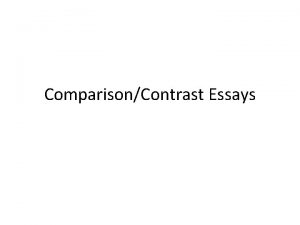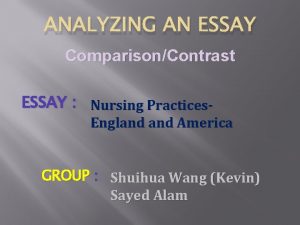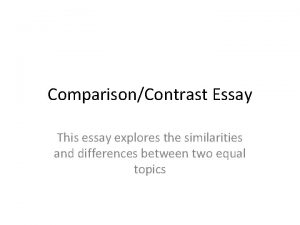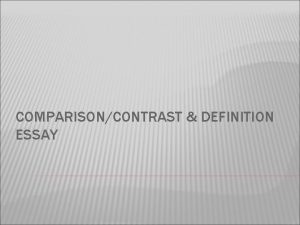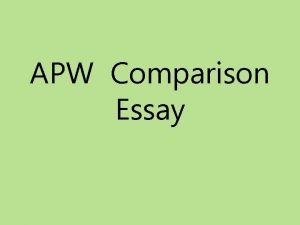ComparisonContrast Essay A How to Presentation Terms Comparison












- Slides: 12

Comparison/Contrast Essay A How to Presentation

Terms • Comparison = similarities • Contrast = differences The literary term comparative essay refers to an essay that has either comparison, contrast or both.

Purposes There are two reasons to write a comparative essay: • To evaluate (i. e: evaluate health care systems in U. S. & Canada) • To inform (i. e: explain the similarities and differences between alligators and crocodiles)

Guidelines • A meaningful comparison must exist between the two subjects • The subjects you chose should be of the same general type. • Example: 2 cars, 2 cities

Essay Structures There are two comparative essay structures a writer can employ • Block Method • Point-by-Point Method

Block Method • Essay is divided into halves • Best with short papers only, where reader does not have to remember intricate detail about Subject 1 while reading about Subject 2

Block Method - Sample Outline Subject: Characters of a novel Paragraph 1: Introduction and thesis Paragraph 2: Character 1 a) Attitude b) Characteristics c) Objectives Paragraph 3: Character 2 a) Attitude b) Characteristics c) Objectives Paragraph 4: Character 3 a) Attitude b) Characteristics c) Objectives Paragraph 5: Conclusion Summarize similarities/differences Draw conclusions from your findings (i. e. state preference)

Point-by-Point Structure • Terms/categories of comparison are determined, then both subjects are explored under each category heading • Advantage – similarities and differences more readily apparent to the reader • Suited to longer, more complex papers

Point-by-Point Structure - Sample Outline Paragraph 1: Introduction and thesis statements Paragraph 2: Attitude • Subject 1 – character 1 • Subject 2 – character 2 • Subject 3 – character 3 Paragraph 3: Characteristics • Subject 1 – character 1 • Subject 2 – character 2 • Subject 3 – character 3 Paragraph 4: Objectives • Subject 1 – character 1 • Subject 2 – character 2 • Subject 3 – character 3 Paragraph 5: Conclusion – restatement of thesis, summing up, final statement

Working Thesis Formulas • Subject 1 and Subject 2 can be compared in terms of a, b, and c. • Subject 1 and Subject 2 can be contrasted in terms of a, b, and c. • Although Subject 1 and Subject 2 are different in terms of a and b, they are alike in terms of c and d.

Final Words of Advice • Make sure your terms of comparison and contrast matter. Ask so what? If you cannot answer, revise! Example: One character had blue eyes the other had brown eyes. (not much more can be discussed!) • Provide transitions for the reader.

WORD OF ADVICE
 Limit convergence test
Limit convergence test Shall i compare thee to a summer's day annotation
Shall i compare thee to a summer's day annotation Polynomial classification
Polynomial classification Combining like terms practice
Combining like terms practice Three degrees of comparison
Three degrees of comparison Introduction for a comparative essay
Introduction for a comparative essay Themes in bayonet charge
Themes in bayonet charge Contoh soal kalimat hubungan perbandingan
Contoh soal kalimat hubungan perbandingan Signal words comparison and contrast
Signal words comparison and contrast Compare and contrast essay alternating example
Compare and contrast essay alternating example Smallest anteroposterior diameter of the pelvic inlet
Smallest anteroposterior diameter of the pelvic inlet 4 maneuvers of leopold
4 maneuvers of leopold Discipline paragraph
Discipline paragraph

